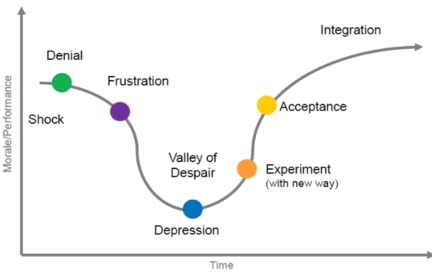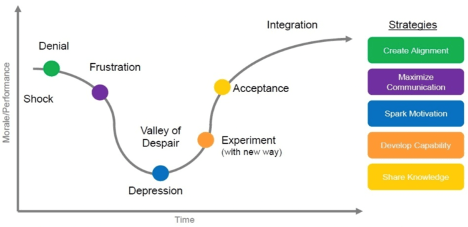Author
| Published: January 25, 2022
Do you need to implement a new tech platform in your organization? Communications pro Laurie Smith teamed up with sales enablement expert Amanda Anderson to break down why and how to use effective communications to ensure your new platform is used effectively.

Here at Inflectiv, we work with clients to implement systems designed to assist the flow of data along the customer lifecycle. This includes CRM systems like Salesforce and HubSpot and additional systems that complete a company’s business intelligence ecosystem. But here’s the thing…
When companies call us, it’s sometimes because their HubSpot is “broken” or their Salesforce “won’t talk to anything.” Most often, we aren’t implementing a system so much as re-implementing one that was incorrectly introduced and not adopted.
When companies don’t have the luxury of operations teams, project managers, or change managers, it often falls to marketers or sales people to source, purchase, implement and manage complex business systems in addition to their usual role. Although it helps to come from the PR and communications side, as someone who has worked in an active M&A environment I can tell you this: it’s always harder than it seems!
This past summer I had the pleasure of working with Laridae, a management consultancy for non-profits. While I was there, Laridae CEO Danielle Rocheleau delivered an excellent session called Communicating Through Change that resonated deeply with me. I hope to capture the best of her advice here, supplemented with the wisdom of my friend Amanda Anderson of TELUS, and with my own experiences as a change manager in the context of software and systems implementation.
If you’re heading into a software implementation project, please read on. These are nuggets you really need to know.
This post covers the following topics:
- How people deal with change and why it matters to understand this before you start
- Considerations for leading change while adapting to it yourself
- Why? The role of context and empathy in change communications
- What to expect from vendors with tech implementation and onboarding
- Tactics that work even with your toughest internal customers
How do people change?
Whatever the change, from staffing or role changes from restructuring, mergers, acquisitions, new products, new growth strategies, or system improvements – there is one thing that stays constant. And that is a need to know. This need is there whether the change is positive or negative, and increases in direct relation to how sudden, shocking or disruptive the change is. Park that just for a moment.
Now, think back to a change in your work life that went relatively smoothly – possibly so smoothly you barely registered it as a big deal. Chances are, you were privy to continuous communication about what, how – and why it was happening.
Elizabeth Kubler-Ross’ change curve describes the typical emotional journey that we experience when dealing with change or transition. It is most often associated with the stages of grief. The shape resembles other diagrams you may know – such as the Gartner Hype Cycle, or the Dunning Kruger effect – both of which demonstrate a deep low before achieving success.


When it comes to change, when first informed, people often reject or ignore the information. You’ll hear, “Oh no, I don’t need that, my excel spreadsheet tells me all I need to know.” Or “My team’s not wasting a minute on this; they have deals to close.”
Chances are whatever you’re hoping to implement cost a fair bit. You needed a business case, or someone did, and senior management had to approve this investment. Now they are looking for ROI – fast. When people realize your change is coming whether they like or not, they become frustrated.
You’ll hear, “This is our third CRM in three years, why do we have to do this?” This is especially true if they weren’t a part of the of the initial trial phase, or if they feel like this change has been sprung on them. “Why wasn’t my team consulted?”
The pit of despair
From here, your people may slide into a pit of despair regarding the new project. At a time when you’re trying to get everyone excited about the benefits of a new software system, it can feel as if you’re only getting a lot of grief for your troubles.
I’m here to tell you: this will happen no matter how skilled you are at communicating, or how deft you are with the new system. As my colleagues at Laridae would say, “You just can’t skip the dip.”
Have faith in the change curve. Eventually, people will start to come around. They will read your emails. They will take the tutorial. They will try it. They will talk about it. They will learn what others are doing, and they will slowly begin to integrate the new way into their daily processes.
Practice leads to acceptance – and this, finally, is where we really start to make progress.
You need to know about this before you start. Why? Because you need to know your audience. Not just who they are – but where they are on this graph so you can tailor your approach and manage expectations (yours and theirs) accordingly.
We have known salespeople who, once informed of the change curve, held “pit of despair” parties after work where they complained about the system to each other over a few drinks!
Leading your own change
If you’ve been asked to get new software for your own team, chances are you’re well along the change curve by the time it comes to fruition. You’ve done research, heard a dozen sales pitches, prepared a proposal, and acquired funding. By the time you’re ready to implement, you’ve been thinking about it for months – but you haven’t used it yet. You’re in the awkward place of being the champion of a system you’ve never tried! You’re both a changer and a changee.
Here’s our best advice:
- Acknowledge that it’s going to be hard. Learning a new software system and leading its rollout is kind of a big deal. Be kind to yourself because it could be a long time before anyone else is!
- Understand and accept how this change to your role impacts you in other ways. Does it alter your morning routine? Does it add more time to your day? Are you talking to more people than you’re accustomed to? Is there anything you can do or prepare in advance to alleviate these stressors?
Spend some time with this information and recognize that when you’re feeling frazzled or irritated, you have a good reason!
Once that’s done:
- Lead by example. Live this change harder and more positively than anyone. People need to see you’ve bought in.
- Become an expert by being a learner. Attend all the training. Do all the homework. Let other people see you learning at the same pace they are.
- Know where to get help. If becoming an expert is posing a challenge, see if you can get extra time with your vendor, or use LinkedIn Learning or other training resources to get ahead. There may also be someone in your company who has used it before and who you can turn to with questions. Share what you learn! Share your resources! Be transparent with your learning curve.
- Answer all the incoming questions with patience – for a long time. Each person will move through the change curve at different pace.
As a change communicator, it may seem like you’re saying the same things over and over. But what’s old to you is still fresh news for anyone coming up behind you.
Know your audience
The first rule of good communication is Know your Audience. With change communications, your audience may be one team or department – but it will by no means be a homogenous group. Within that group you’ll have people that are more – or less – impacted by the change. You may have different languages or time zones to consider. You will also have hierarchy to consider. You will want to ensure your communications pieces (emails, training sessions, Q&A) are tailored to meet the different needs of your audience, which could mean several versions of each to manage.
Within your audience you will also have ‘personas of change’ as follows:
Resisters
You can expect about 20% of your audience (whether users or managers) to be resisters. Unsurprisingly, this group will resist or even disrupt your progress. They will need more information than the others and they will take longer to process it. Bringing them in early is a good tactic so they have more time with the material, and you have more time to help them.
Winning over resisters is a popular topic in change management. Resisters, once bought in, can become your most effective champions.
Bystanders
Bystanders make up the bulk of your audience. They will change, but in the early days they’re on the sidelines watching it play out with the resisters. When preparing your communications materials and your training, keep this silent majority in your mind.
Helpers
Helpers are pro-change; they’re just not vocal about it. They’ll do what you’re asking of them, and they’ll quietly help others do it too. You may not know who they are at first, but trust that they are there.
Champions
This is your fan club! They are already changing! You can leverage their enthusiasm to influence your bystanders and resisters, and you can ask them to help you in many other ways from remedial training to leading user groups.
An excellent tactic for rolling out change is to create an implementation steering committee that contains people from all of these groups. This gives resisters time to work through the curve before the majority – and gives champions more ‘time in market’ to get people excited.


Why? The role of context and empathy in change communications
If you think back to the change graph, those first few points of denial and frustration will often result in people asking: Why are we doing this?
It couldn’t be more important to get the answer right.
When someone is privy to the ‘why’ behind a change, you will immediately get more buy-in from that person. Framing this initial message is an incredible opportunity that you only get once.
This is not a “because I said so” moment. This is also not a “because it benefits the business” moment. This is a “what’s in it for you” moment.
If you don’t explain why, people won’t see value in going ahead with it – and they won’t get to the next important phase, which is to imagine themselves doing it.
As you prepare your messaging, understand that:
- People need to know why — in the context of their role. Prepare to demonstrate that you’re aware of what they do and how this change impacts them specifically. They need to imagine themselves in the change and understand what they will have to do differently.
- They need to believe in this change as a sensible course of action that benefits them and benefits others important to them, such as customers (which indirectly benefits them).
If you can create messaging that explains why, in context of role, you’re mostly there.
Communicating with context and with empathy helps people to process the information faster and to make decisions quicker.
Prepare yourself (and your communications) to also address how people might FEEL. What they might THINK. If you understand their roles, it shouldn’t be too difficult to:
Put yourself in the other person’s shoes: Think about the other person hearing what you have to say for the first time and frame your context to their needs.
For example: Salespeople need to learn a new system to automate reporting. But time away from selling makes them feel anxious about not meeting targets. They may think this isn’t a valuable investment of time.
Focus your message on the time that will be saved once the initial training investment is complete.
Consider Stephen Covey’s advice that change moves at the speed of trust. When you communicate information without any context and without empathy, it creates instant mistrust.
For example: If you simply say, “We are introducing this new software and you have until month end to get up to speed,” your audience will be instantly suspicious. Why month end? Are you changing my targets for next month? If you want to develop trust (and trust us, you do) you need to avoid putting others on the defensive. Level the power dynamic by sharing as much as you can about what you know.
It is very important to avoid the ‘perception of secrets’ in your change management. Not being privy to important information creates fear. If people hear information without context, it can bring up fear around what else they might not know. Setting context – with empathy – removes the ambiguity and helps to allay any anxiety.
You might say something like this: “This new software tracks your activities. Sharing this level of detail with your manager might seem strange, but it can work to your advantage. Let me explain how.”
Proactively answer their questions: If you are empathetic to your audience, you should be able to anticipate inevitable questions and answer them before they are even asked. Be sure to address the elephant in the room head on, even if it’s uncomfortable.
For example: “Some of you will be thinking that this is new system a Big Brother move by the business. Let me explain what I know about that.”
Communications planning
Create a plan that sets out how your change communications will roll out. Most pro communicators can set up plans in their sleep – but you may not be a pro communicator, in which case you may doubt you need a plan at all. Trust us, you do.
You can use a Plan document to house your messaging, specific details about your audience, distribution channels, timing, and more. It should contain a list of the tactics you will use and when you will use them in a format that makes it easy for you to stay on top of your duties.
It helps you remain clear on what you need to say and do. You can also share this Plan with others to refine it far in advance of any rollout.
Our best advice is to deploy a formula of context + empathy + frequency + ubiquity + time
- Create messaging that works for your audience in context of role and which displays empathy for what they may think and feel. A good tip is to create a common purpose – move it from a “they” decision to a “we” advantage.
- No surprises! Prepare to start communicating about this change well in advance. Set a regular cadence of updates as the roll out date approaches, throughout the entire process, and after too – until the very last resister is on board.
- Use every channel available to you. Don’t assume people read your emails!
- Continue for as long as it takes. The best way to know you can stop communicating is when people ask you to stop.
Create messaging that works for each audience. As mentioned earlier, this could mean creating different versions of Q&As, emails, training guides, videos – whatever tactics you deploy.
A common example is a company that is consolidating systems because of an acquisition. Half of your audience is moving to a completely new CRM. The other half is moving to a revised version of the same CRM they were using before. This group has a significant head start, but nonetheless needs to learn new things. Their communications needs will differ.
Another common example is when the team and their managers both need to learn the new system, but for different purposes. Our best advice? Start with the managers!
Tell them first, train them first, set them up for success by supplying them with adequate resources to address their teams’ questions. Even though you’ve made yourself available – staff will go to their managers first with a problem.
Communication tactics we’ve seen work well include:
- Steering committee of peers
- Drip announcement campaign (several pre-announcements reminding people of the launch date, what’s to be expected, and what they need to do by when).
- Tailored messaging (manager/staff)
- Emails / follow ups in same thread
- Slack or Teams – create a new channel just for implementation
- Town Hall presentation
- Stand up meetings / team meetings
- Office hours / AMA sessions
- Training / tutorials / remedial sessions (vendor or champion-led)
- Feedback loop – dedicated channels to invite and resolve complaints or issues
- Resource site / Sharepoint page, etc. to house all documentation
- Q&A (update and reshare)
- Contests to reward adoption or behaviour
- Success stories from real users
- Videos / walkthroughs of real users demonstrating their use of the system
- Surveys (for feedback loop)
- Vendor visits / AMAs with vendor
- Case studies (from other companies)
- In-person check ins
- Newsletters
- Wind-down celebration
Communicating along the change curve
Let’s look at the change curve again, but this time with some ideas for what to say when.
In the very early days of shock and denial, you’re looking to inform. Remember: If people don’t have the facts, they will invent their own version of the change story. Communicating early and often prevents a mismatch of expectations. This is a key time to align your entire audience, using transparency and trust.

 By the time people have had time to consider what you’ve told them, and are frustrated, you need to be in full launch mode for your communications materials and messaging. At this point, you have released a good deal of communication explaining why, how, when and what people need to do in the context of their jobs, and you have proactively addressed their fears.
By the time people have had time to consider what you’ve told them, and are frustrated, you need to be in full launch mode for your communications materials and messaging. At this point, you have released a good deal of communication explaining why, how, when and what people need to do in the context of their jobs, and you have proactively addressed their fears.
Knowing they will soon hit the pit of despair; all of this communication is to arm them with the information they will need to climb out again. It’s a good time to add a little spark to your tactics. This is a good time to launch a contest, pull in some of your champions and create a fun video, or establish peer-to-peer remedial sessions. You might want to host a Pit of Despair party! Whatever you decide to do, your goal is to nudge them into the experimentation phase.
As people begin to use and experiment with the platform, it’s time to set up office hours, join team meetings, book 1:1 tutorials, or proactively offer information to anyone who will listen. This is also a terrific time to share success stories of how others are seeing good results. Start with your champions but seek to promote resisters too.
As your new project achieves widespread acceptance and becomes integrated, don’t stop! Keep checking in. Use whatever tools available to assess adoption and connect with anyone who seems to be lagging. Query managers to find out how they’re doing separately from their teams.
What to expect from software vendors


It’s very important to understand what help you get from your vendors when you’re negotiating your contract with them. In my experience, it’s usually less than you would expect and always less than you need. Vendors do their best to move from closing the sale to having customers up and running as quickly as possible – sometimes too quickly. The handoff from sales to onboarding to training can be quick – and sometimes it’s messy.
Consider these four themes: Pre-rollout, Setup, Launch, and Post Launch.
At each stage, really examine and question what is included in your vendor contract.
For example: Will you have access to customer success/trainers to help you? What about help from an onboarding team post launch?
Make sure it’s very clear from your vendor how long a typical installation takes. Ask for some use cases of other businesses like yours.
Ask what kind of reporting vendors can offer to support your roll out and to determine ROI. Does the software allow you to track logins, view learning courses taken, minutes spent in platform, attribute adoption to revenue generating activities, etc.?
Ask specifically about the implementation and onboarding service you can expect from vendors. This may be a specific number of hours with a dedicated specialist, or access to a training library, or both – or none.
I can remember a time I invited my team to what I thought was a kickoff call for a set of training sessions. At the end of the hour, the presenter wished us well. It turned out that one hour was all we got! Had I understood this in advance, I would have used the hour much differently – possibly inviting only my champions so we could ask deeper questions and prepare to train the larger team ourselves.
The thing to remember is you’re not alone. Software implementation is, in fact, such a huge subject with so many facets that there are resources everywhere. The challenge may be in winnowing it down on Google to a few that really work.
LinkedIn Learning is a friend if you’re fortunate to have it, from anything from project management and communications in general, to detailed software skills. It’s worth a look if you’re struggling.
Vendor sites, like Salesforce Trailhead or Hubspot Help Centre are chock full of helpful tips that you can apply to any implementation – if your own vendor site is lacking.
Loom is an exceptional product to generate fun video walk-throughs for those of you who don’t have fancy Learning Management Systems (LMS). Sites like Grammarly can help you put polish on your writing. Try Canva for images and creative templates. And of course, Zoom.
A final word
Change communications and change management are essentially the same thing. If you’re understanding your audience, using context and empathy in message-setting, timing your information with key phases of adoption, being transparent about why, leveraging your internal champions and using all the channels you have available, you’re not just communicating: you’re running the whole show.
Good luck!
This was based on the Why Are We Doing This? webinar, which you can view on demand here.


Laurie Smith is a Mobilizer at Inflectiv, where she leads communications, marketing and revenue operations programs for a wide range of clients.

